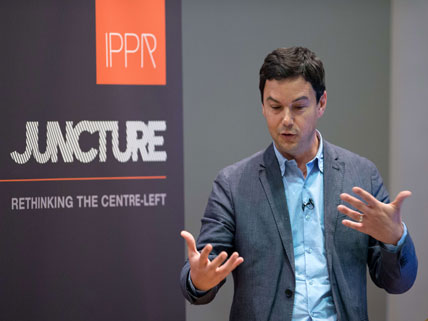
French economist Thomas Piketty, author of Capital in the 21st Century
What Occupy Wall Street did to popularize the cause of protesting against the concentration of wealth in the hands of “the 1 percent,” Thomas Piketty’s Capital in the 21st Century has now done to highlight the issue in the field of economics. A French economist, Piketty has written a 577-page (nonfiction) bestseller that warns of widening economic inequality—the issue that President Barack Obama has called “the defining challenge of our time.” For many critics of capitalism, there’s no debate: of course the rich are getting richer and the poor are getting poorer—who needs proof?
Essentially Piketty’s book claims to provide proof of increasing global economic inequality based on both past and current trends that he sees in the data. However, on the question of whether the data support his assertion, economists’ opinions differ, and not just because they bring opposing political views to the table. It’s a particularly thorny question mostly because it involves analysis of historical data of different types and from varied sources. Information that might shed light on inequality has not necessarily been collected the same way in different times and in different countries. Then there are tax complications. Such factors can make comparisons difficult and conclusions shaky.
Economist Gary Burtless raises an important objection to the findings in Capital in the 21st Century. He points out that measures of income from which Piketty derives the picture of increasing inequality fail to count the value of government social benefits. In the United States such benefits, or transfer payments, happen to make up 17–18 percent of personal income. They include social security, welfare, unemployment compensation, and so on, much of which is received by those with lower incomes. Not only that—the lion’s share of income taxes are paid by higher-income groups. For example, the top 1 percent pays more in income taxes than the bottom 90 percent combined. To the extent that transfer payments raise “income” for one group and taxes lower income for another, inequality is lessened.
Image credit: © LEON NEAL/AFP/Getty Images
Related Links
- Thomas Piketty’s “Capital”, Summarised in Four Paragraphs
As the title indicates, here’s an attempt at a summary of Piketty’s tome, Capital in the 21st Century.
(Source: Economist, May 4, 2014) - Piketty’s Rickety Economics
This opinion piece from the journal Defining Ideas, published by the Hoover Institution, a public policy think tank, counters Thomas Piketty’s conclusions in Capital in the 21st Century.
(Source: Hoover Institution, May 12, 2014) - The Facts on Inequality, Wealth, Income, and Working May Surprise You
Listen to this in-depth podcast interview with Gary Burtless, an economist with the Brookings Institution; the discussion ranges across issues of income and inequality, social programs and employment, and much more.
(Source: Brookings Institution, May 21, 2014) - Opposite the Headlines, Income Inequality has Gone Down over the Last Two Decades
This article by the nonprofit think tank critiques earlier work on inequality by Emanuel Saez, a colleague of Piketty.
(Source: Tax Foundation, September 13, 2013)




To compare the top 1% paying 90% of the taxes to the fact that social program payments are received by those in the lowest ranks is inane. Transfer payments may raise the income of some and taxes lower the income for another, does not take into account the perspective involved in the situation. When someone has nothing and they receive aid of $10,000 in a year, the difference is palpable. I’m not sure the person making hundreds of thousands or millions of dollars a year is all that greatly impacted by the increase in tax. To say that inequality is lessened by this situation is ludicrous. That’s like saying that taking 10,000 gallons of water out of the Atlantic and putting it in Lake Michigan has helped lessen the inequality of how much more water the Atlantic has. Sure, water was moved, but the amount is insignificant on both sides and in the end does nothing to substantially change the situation.
Humbaba3000BC,This is indeed an ioarmtpnt feature that we must find a better way of solving as we add more and more indicators. For now, the best, but clearly very imperfect way, is to go to the page indicators in gapminder world (you find it in the right side on the top of this page):There you can find a link called download indicator list to excel . If you download that list you get the present list of indicators we have, and the headings of each indicator (in the columns menue level 1 and menue level 2 .Once you have the list you can use the search functions in excel to find the indicators you want, and see under what headings in the graph you find them.Hopefully we come up with some better way of searching for indicators in the not too distant future.Regards,mattias, Gapminder